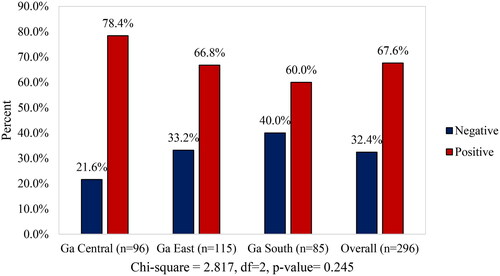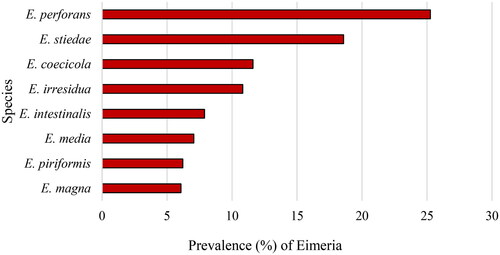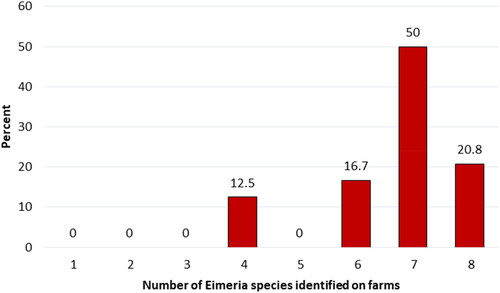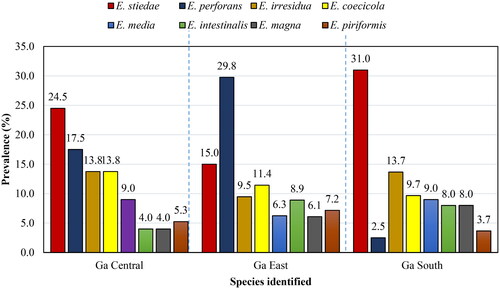Abstract
Raising of rabbits for wealth creation and to improve protein intake among resource-poor communities is a potentially impactful venture. However, common parasitic infestations are among the major challenges to the sustenance of such ventures. Parasites such as Eimeria spp. which cause coccidiosis affect rabbit growth rate and may result in high mortalities. This study was conducted in response to increasing kit mortalities in three municipalities in the Greater Accra Region of Ghana. Two hundred and ninety-six samples of fresh faecal droppings were collected from the faecal trays of rabbits and individually examined for Eimeria oocysts using light microscopy. Prevalence of Eimeria ranged from 60% (Ga South) to 78.4% (Ga Central), with overall prevalence of 67.6%. Eight species of Eimeria were identified namely, E. stiedae, E. intestinalis, E. magna, E. coecicola, E. piriformis, E. irresidua, E. media, and E. perforans. The hepatic species, E. stiedae was dominant in two municipalities and was the overall second most dominant. Rabbits in parts of the Greater Accra region are infested with Eimeria spp. To the best of our knowledge, this is the first research-backed report of rabbit Eimeria spp. in the Greater Accra region. More research is required on the impact of coccidiosis in rabbits in Ghana.
REVIEWING EDITOR:
Introduction
Raising of rabbits (Oryctolagus cuniculus) for wealth creation and to improve protein intake among resource-poor communities is a potentially impactful venture (Lukefahr & Cheeke, Citation1990; Mensah et al., Citation2014). In Ghana, such an attempt at making the populace self-reliant in meat production was made by the establishment of the National Rabbit Project (NRP) in 1972 although production decreased significantly when the project ended (Opoku & Lukefahr, Citation1990). Interest in rabbit production has begun to rise again, with people from all educational backgrounds engaging in it especially in urban dwellings. It is being promoted as a livelihood strategy for landless farmers in both rural and urban areas due to its limited requirements for resources such as space, feed, capital, and labour (Osei et al., Citation2012). Rabbits have the potential to generate tonnes of healthy lean meat within a relatively short time due to their prolificacy, low herbage intake, and high feed conversion. Also, with a short gestation period of about 30–33 days in rabbits, farmers have the potential to increase production in a relatively short time (Beaumont et al., Citation2004; Abu et al., Citation2008). For this advantage to be realized, however, attention must be paid to all factors of its production through the support of research. Constraints in rabbit production are relatively few, but parasitic infestations are a challenge. All the major intestinal parasite species; nematodes, trematodes, cestodes, and protozoa are found in rabbits (Eslampanah et al., Citation2014; Raue et al., Citation2017).
The protozoan Eimeria, the causative agent of coccidiosis remains one of the extremely important parasites in rabbit production, causing considerable economic losses in commercially reared rabbits (Yin et al., Citation2016). The disease affects organs such as the bile duct, intestines and liver, and losses may occur through the effects of high morbidity and mortality (Maertens et al., Citation2000, Abdel Megeed et al., Citation2005; Manjunatha et al., Citation2019). The species of Eimeria infesting rabbits are numerous with different levels of pathogenicity. They occupy various niches in the intestine and the liver (Coudert et al., Citation1995; Pakandl, Citation2009; Papeschi et al., Citation2013). Not all the species cause disease though. Eimeria coecicola, E. vejdovskyi, E. exigua and E. perforans are non-pathogenic to slightly pathogenic and would very rarely cause disease, while E. piriformis E. irresidua, E. media, and E. magna are pathogenic. Among the most pathogenic ones are E. intestinalis and E. flavescens (Lebas et al., Citation1997). Eimeria stiedae occupies the bile ducts in the liver and is highly pathogenic in many cases (Hauptman et al., Citation2001). Mixed infestations with different species of Eimeria can occur in the same rabbit (Jithendran & Bhat, Citation1996; Eslampanah et al., Citation2014). The impact of infestation is varied and is dependent on the species of Eimeria involved, the dose of oocysts, as well as the age and physiological state of the rabbit. High levels of mortality often occur in young rabbits in the early stages of weaning (Chowdhury & Fraser, Citation2008; El-Ghoneimy & El-Shahawy, Citation2017).
The universal spread of Eimeria spp. calls for regular monitoring and institution of preventive measures to control the rate of infestation. In Ghana as far as the authors are aware, the presence of Eimeria spp. in rabbits has not been confirmed through research although it is highly suspected to be present in the country. Thus, some farmers give their rabbits anticoccidial drugs based on advice from agricultural extension officers, colleague farmers, and from their own personal experiences. Available scientific publications on rabbit rearing in Ghana are on production, nutrition and economics (Karikari & Asare, Citation2009; Appiah et al., Citation2011; Karikari et al., Citation2011; Osei et al., Citation2012; Mensah et al., Citation2014; Osei et al., Citation2019). However, as interest in rabbit production is increasing in the country, it is also necessary for key health related issues to be closely looked at to put in place mitigating measures to promptly tackle challenges. The particular focus of this study was to establish the presence, prevalence, and species of Eimeria on some rabbit farms in the Greater Accra region of Ghana.
Materials and methods
Ethical approval
This study did not involve direct handling of the animals or application of any medication. Therefore, there was no requirement to obtain ethical clearance.
Study area
This was a cross-sectional study carried out in three selected municipalities in the Greater Accra Region of Ghana. The three municipalities, Ga Central, Ga East, and Ga South () were selected due to reports of frequent episodes of diarrhoea and high kit mortalities that farmers made in 2019 at the Research Extension Farmer Linkage Committee (RELC) planning session of the Ministry of Food and Agriculture. Suspecting that the cause could be coccidiosis, a study was conducted on selected farms in the three most affected municipalities to confirm or rule out coccidia.
Figure 1. Map showing the municipalities where samples were taken from in the Greater Accra region of Ghana.
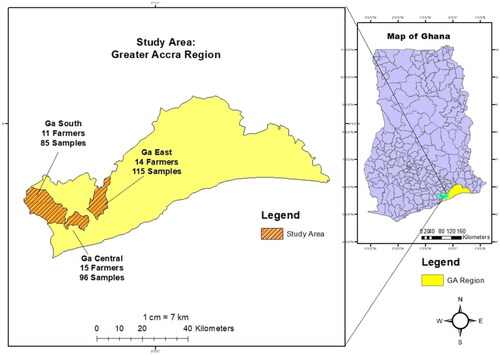
All the three municipalities fall within the coastal savannah ecological zone which is highly distinguished with regards to its relatively low rainfall and grassland savannah vegetation. It is also densely populated and farmlands are limited.
Husbandry practices
Management practices on the farms were observed and discussions were had with farmers during sampling visits for the purpose of gaining insight into how their practices may influence infestation rates with Eimeria spp. A total of 1,811 rabbits were stocked on the farms. Rabbits were kept in cages of varying sizes made of welded mesh. Does were kept in single cubicles, and does with kits were kept together until kits were weaned, usually at about six to eight weeks of age. Weaned kits were kept together in groups depending on the size of the cages. It was observed that all the farmers used wire mesh for construction of cages, including the floors, which allowed faecal droppings to fall through onto collection trays. However, the mesh floors of the cages were only brushed every few days in most farms. Disinfecting the cages was not a part of their husbandry practices.
Study design and population
A total of forty rabbit farms were visited (). Thirty-one of these farms were randomly selected from the lists of rabbit keepers (42) obtained from the Municipal Directorates of Agriculture (MDAs). A high percentage of farms was chosen from the list obtained because although more people are going into rabbit production, the numbers registered with the MDAs are low. Again, since to our knowledge there is no data on the prevalence of rabbit Eimeria spp. in Ghana, and the reports of mortalities came from those farmers registered with the MDAs, it was important to capture as many of those farms as possible. The remaining nine were obtained through snowballing. This was done to capture some of the farms that were not registered with the MDAs.
Table 1. Number of farms visited in each municipality and samples collected.
Literature on production rates in Ghana indicate that though more people are venturing into rabbit production, the number of animals kept are low, mostly as backyard and small-scale farms (Osei et al., Citation2012; Sarfo, Citation2017). The classification as to what constitutes small to large scale rabbit farms in the country is largely relative at the moment. Thus, solely for the purpose of this study, farms with up to fifty rabbits were categorized as small scale, whereas those above fifty were categorized as medium to large scale.
Sample collection
Two hundred and ninety-six fresh faecal samples were collected from the faecal trays of rabbits () held in cages individually and in groups from November 2019 to February 2020. Groups of rabbits from whose trays faecal samples were taken included bucks, does with their kits, and weaners. Faecal samples were collected into clean plastic pill boxes and transported to the Parasitology Laboratory of the Council for Scientific and Industrial Research-Animal Research Institute on ice for processing. Samples were kept in batches at 4 °C until processed. At the time of sampling, all rabbits appeared apparent healthy.
Laboratory analysis-Eimeria oocysts counts and differentiation
Faecal samples were initially prepared individually using saturated sodium chloride solution floatation techniques (Garcia, Citation1999). Eimeria oocysts were counted using the Modified McMaster Method described in MAFF (Citation1986). The McMaster counting technique is a quantitative technique used to determine the number of oocysts per gram (OPG) of faeces. The supernatants of Eimeria-positive samples were further pooled together according to farms and incubated for up to three days in 2% potassium dichromate solution at room temperature to sporulate the oocysts. Sporulated oocysts were observed with a calibrated binocular microscope (x400 magnification) and identified using morphological and morphometric criteria described in MAFF (Citation1986) and Garcia (Citation1999). From each pooled sample, differentiation of Eimeria species was done by counts of two hundred oocysts drawn from thoroughly mixed incubated supernatant.
Statistical analysis
Data was entered using Microsoft Excel version 2021, and statistical analysis was performed in Minitab Statistical Software version 20. Descriptive statistics such as means, frequency tables and charts were generated to show the status of Eimeria spp. infestation in rabbits in the different selected locations. ANOVA tests and subsequent Duncan’s multiple range tests were used for analysis of oocysts counts in different groups. Results are expressed as means ± SE. Probability of values less than 0.05 (p ≤ 0.05) was considered significant.
Results
Prevalence of eimeria spp. on selected farms
In the municipalities investigated, the overall prevalence of Eimeria spp. infestation was 67.6% (95% confidence interval 62.1–72.7%) out of the 296 faecal samples collected. The parasite was present on all 40 farms prospected. When reviewed according to municipalities, the prevalence varied from 78.4% in Ga Central, 66.8% in Ga East, and 60.0% in Ga South ().
Modelling eimeria spp. infestation among rabbits
The results revealed that the risks of infestation with Eimeria spp. were 3.71 and 1.63 times more among rabbit farms in the Ga East and Ga Central respectively compared to farms in Ga South (having the lowest prevalence and used as the point of reference). Farms with more than 50 rabbits were found to be 1.94 times more at risk of infestation with Eimeria spp. compared to farms with less than a total of 50 rabbits on the farm. The test results further revealed that kits that were kept in groups of 10 or more in a cage were 2.02 times more at risk of Eimeria spp. infestation ().
Table 2. Modelling Eimeria spp. infestation among rabbits.
Intensity of infestation with eimeria
The intensity of Eimeria infestation is shown in as average OPG counts. The results show that in the 200 samples that were positive for Eimeria spp. across all the three locations, the oocyst load ranged widely from less than a 1000 to over 10000 per gram of faecal matter with a geometric mean of 6.46299 × 103 ± 7.273175 × 104. Majority of the samples (74%) had intensities of over 1 × 104 OPG of faecal matter. The intensity of infestation with coccidia was found to be significantly higher (8.21461 x 103 ± 9.863086 × 104) among farms with more than 50 rabbits (p-value = 0.040) compared with farms with fewer rabbits. Farms that stocked more than 10 rabbits per cage had the highest intensity of infestation (5.65504 × 103 ± 2.6946421 × 105), followed by those that kept 6 – 10 rabbits in a cage (6.98575 x 103 ± 1.8511818 × 105). Rabbit farms in the Ga East recorded significantly higher oocyst counts (6.03154 × 103 ± 9.410602 × 104) compared to the other two municipalities (p-value <0.05).
Table 3. Mean OPG count for Eimeria spp.
Species of Eimeria affecting rabbits
The study revealed the presence of eight species of Eimeria. shows the morphological characteristics and shows the range of measurements of the oocysts identified for the various species.
Figure 3. Shape and size characteristics of Eimeria oocysts used in differentiation. a. E. stiedae, b. E. intestinalis, c. E. magna, d. E. coecicola, e. E. piriformis, f. E. irresidua, g. E. media, and h. E. perforans. The scare bar of 50 µm applies to all images.
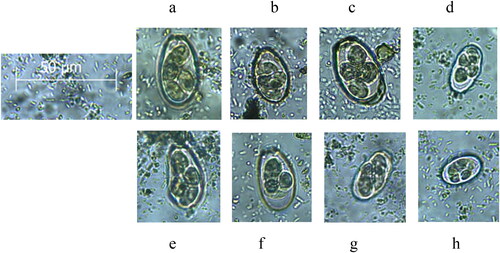
Table 4. Morphological and size (means) characteristics of species of Eimeria identified in the three municipalities of the Greater Accra region.
Overall, E. perforans was the most prevalent species identified (), followed by E. stiedae and E. coecicola with respective relative frequencies of 25.26%, 18.58% and 11.61% (p < 0.001). The relatively fewer species encountered were E. media (7.8%), E. piriformis (6.21%) and E. magna (6.07%).
Occurrence of mixed eimeria spp
Between four to eight species of Eimeria occurred on individual farms. When all three municipalities were combined, 50% of all farms had seven of the Eimeria species, while 20.8% of farms had all eight. Six species of Eimeria were identified on 16.7% of all the farms and four species were found on 12.5% ().
Distribution of Eimeria species within the three municipalities
All eight species were detected in samples from the three municipalities. However, the distribution varied (). In the Ga Central Municipality, the three most dominant Eimeria species found were E. stiedae (24.5%) followed by E. peforans (17.5%) and E. irresidua (13.8%). In Ga East, the three most dominant Eimeria species were E. perforans (29.8%), E. stiedae (15.0%) and E. coecicola (11.4%). In the Ga South, E. stiedae (31.0%) was the most dominant Eimeria species identified followed by E. irresidua (13.7%) and E. coecicola (9.7%).
Discussion
One of the major challenges in rabbit production is diarrhoea in kits that may result in morbidities and mortalities if the causes are not quickly determined. Parasitic infestations are often common culprits in such instances. Many factors promote introduction and establishment of coccidia infestations including husbandry practices. Spacious and disinfected housing are important factors for the control of coccidia (Pilarczyk et al., Citation2020). On some of the farms, placement of cages meant that aeration was not optimum, making them a conducive environment for diseases. Another worrying trend was that cage floors were not regularly brushed or were only casually brushed, while other farmers left faecal collection trays to pile up with faecal droppings for days before emptying. These can become a source of infestation. Disinfection of cages, even when new rabbits are being introduced into used cages was not part of the farmers’ management practices. This makes room for the perpetuation of coccidia infestation as the species are environmentally stable for months. There is currently no vaccine against Eimeria available for rabbits (Abd El-Ghany, Citation2020). Thus, farmers must observe strict hygienic practices and the use of coccidiostats as prophylaxis to control the prevalence of Eimeria spp. on their farms.
The prevalence of coccidiosis varies in rabbits and is influenced by geographical location, season, as well as management factors like housing and rearing conditions, and the use of preventive coccidiostats (Chowdhury & Fraser, Citation2008). The overall prevalence of Eimeria infestation observed across the three municipalities was comparable to that reported by Jing et al. (Citation2012) from Northeast China (65%), although a higher prevalence of 90% has been reported by Maziz-Bettahar et al. (Citation2018). Also, our prevalence falls within the global prevalence of 64% to 100% as reported by Duszynski and Couch (Citation2013). That we did not observe any significant differences in the prevalence among the three municipalities could be a result of similar practices in farm management. Although some differences in husbandry practices were observed during sampling, most of the farmers were doing similar things, especially when it comes to cleaning. Another factor that may have influenced the lack of significant difference in the prevalence may be the geographical location. All these farms were located in the same ecological zone with similar environmental conditions. Even so, we wanted to find out whether the municipal prevalence could have any influence on infection rates.
Modelling of Eimeria spp. to determine the likelihood that unaffected rabbits in the studied municipalities could be infested, using Ga South with the lowest prevalence as the point of reference revealed interesting results. Ga East, having the second lowest prevalence and yet demonstrating the highest likelihood of rabbits being affected in that municipality could be attributed to the stocking density (Mohamad-Radzi et al., Citation2021). For example, it was observed that the risk increased when cage stocking was more than 10. The source of rabbits may also play a role in the spread of disease on a farm, though this was not pursued as it was initially not an objective in this study. A common practice among farmers when they want to start raising animals or restock is to buy from their closest colleague farmers. We speculate that farmers in the Ga East may be buying breeder rabbits from sources that already have Eimeria infestation. Again, on comparing the total farm population, it was observed that farms that kept fifty rabbits or more were 1.94 times more likely to record Eimeria on the farm, irrespective of the municipality. This does not mean that farmers will have to keep fewer than fifty animals during any production cycle in order to reduce the risk of coccidia infestations. What may be happening is that as the number of rabbits reared on the farm increases, husbandry practices, especially maintaining farm hygiene may suffer. Thus, it is imperative that as farmers seek to increase rabbit production for increased income, attention is paid to maintain proper farm hygiene practices (Okumu et al., Citation2014).
The low intensity of infestation found on some of the farms could either be new infestations or infestations that were being controlled naturally by the affected rabbits, as in immunologically competent rabbits, intensity of infestations will decrease over time (Pakandl et al., Citation2008). The intensity of infestation, determined here by oocyst counts is important because depending on the species of Eimeria, doses of as low as 103 could cause diarrhoea and mortality, while some require doses of up to 106 to cause even a slight impact on the growth of the rabbit (Lebas et al., Citation1997). Although all rabbits were declared apparent healthy by a veterinarian at the time of sampling, affected rabbits were at a stage where they could easily succumb to coccidiosis had they become immunocompromised. Coccidia have a short life cycle and can multiply and spread quickly (García-Rubio et al., Citation2017). These infested rabbits will also shed the coccidia in their faeces, becoming a source of infestation to other rabbits on the farm. However, because this was a one-time sampling, rabbits were not followed to determine whether intensity of infestations decreased or increased, and whether any rabbits developed clinical signs of coccidiosis. Ga East, with the second highest prevalence and yet recording the highest average OPG counts highlights the need to go beyond just establishing the presence of Eimeria during investigations. The intensity of infestation is important because severity of disease is dependent on among other things, the number of ingested oocysts (Papeschi et al., Citation2013). Thus, the higher the OPG count, the more likely it is that rabbits will shed and ingest greater numbers of oocysts.
Identification of eight species of Eimeria across the municipalities was not particularly strange as other researchers have reported similar findings (Maziz-Bettahar et al., Citation2018), although the species dominating infestations vary. What is of concern is the hepatic E. stiedae which was the second most dominant species. This finding is significant because E. stiedae is highly pathogenic and causes damage to the liver, and can result in rapid death of the animal (Kvicerova et al., Citation2008). It is therefore very likely that E. stiedae was partly, if not largely responsible for the mortalities that were reported by the farmers in the municipalities. However, because many farmers did not and still do not make it a regular habit of sending dead livestock for post-mortem analysis, it is possible that signs that would have pointed to the involvement of E. stiedae would have been missed. The fourth and fifth most dominant species; E. irresidua and E intestinalis are both pathogenic and can cause disease in doses of 1 x 105 and 103 oocysts respectively (Lebas et al., Citation1997) and are therefore important. E. media, E. piriformis, and E. magna also give reason for concern as all three species are pathogenic.
Mixed Eimeria infestations in the same rabbit is common (Jithendran & Bhat, Citation1996). While the study did not focus on individual rabbits, it is possible that the presence of multiple species observed on the same farm could mean multiple species present in individual rabbits. It is not clear how specific species of Eimeria in a mixed infestation interact with each other, and the consequence for the rabbit. But evidence from mixed infections in broiler chickens indicate that the outcomes could be severe (Akhtar et al., Citation2015). We again speculate that some of the deaths reported by the farmers may have been caused by the presence of multiple Eimeria spp. in individual rabbits.
That E. stiedae was the most dominant in two out of three municipalities, and the second most dominant in the Ga East municipality calls for urgent action to reduce Eimeria infestations in rabbits in order to curb greater losses in the near future.
Conclusion
Rabbits in parts of the Greater Accra region of Ghana are infested with Eimeria spp. Eight species have been identified in three municipalities. To the best of our knowledge, this is the first research-backed report of Eimeria spp. in rabbits in the Greater Accra region. More research is required on the impact of coccidiosis in Ghana.
Author contributions
Conceptualisation: Doreen, Doris, Nikki
Field work: Doreen, Doris, Siegfried
Laboratory work: Julius, Antoinette
Data analysis: Bernard, Doreen
Manuscript: Doreen, Nikki, Siegfried, Doris, Bernard, Julius, Antoinette
Disclosure statement
No potential conflict of interest was reported by the author(s).
Data availability statement
The data that support the findings of this study is available from the corresponding author, [DDON], upon reasonable request.
Additional information
Funding
Notes on contributors
D. D. Owusu-Ntumy
D. D. Owusu-Ntumy (Mphil and MSc.). Research interests include Molecular Microbiology, Science communication.
N. Owiredu
N. Owiredu (PhD). Research interests include meat science and food safety.
D. Y. Osei
D. Y. Osei (PhD). Research interests include rabbit nutrition.
B. B. Borteih
B. B. Borteih (MPhil). Research interests include statistics.
S. Afedzie-Obresi
S. Afedzie-Obresi (PhD). Research interests include agricultural economics.
J. Beyuo
J. Beyuo (BSc.). Research interests include parasitology.
A. Keleve
A. Keleve (HND). Research interests include parasitology.
References
- Abd El-Ghany, W. A. (2020). Coccidiosis: A parasitic disease of significant importance in rabbits. World’s Veterinary Journal, 10(4), 1–11. https://doi.org/10.54203/scil.2020.wvj60
- Abdel Megeed, K. N., Abuel Ezz, N. M., & Abdel-Rahman, E. H. (2005). Protective effect of Eimeria stiedae coproantigen against hepatic coccidiosis in rabbits. Journal of the Egyptian Society of Parasitology, 35(2), 581–595. PMID: 16083069.
- Abu, O. A., Onifade, A. A., Abanikannda, O. T. F., & Obiyan, R. I. (2008). Status and promotional strategies for rabbit production in Nigeria. In G. Xiccato, A. Trocino, and S. D. Lukefahr (Eds.), Proceedings of the 9th World Rabbit Congress. Verona, Italy. 10–13 June, 2008 (pp. 1499–1504). Fondazione Iniziative Zooprofilattiche e Zootecniche.
- Akhtar, M., Awais, M. M., Anwar, M. I., Ehtisham-Ul-Haque, S., Nasir, A., Saleemi, M. K., & Ashraf, K. (2015). The effect of infection with mixed Eimeria species on hematology and immune responses following Newcastle disease and infectious bursal disease booster vaccination in broilers. The Veterinary Quarterly, 35(1), 21–26. https://doi.org/10.1080/01652176.2014.991048
- Appiah, P., Nimoh, F., Tham-Agyekum, E. K., & Tracoh, L. Y. (2011). Rabbit technologies: Adoption studies in the Ashanti Region of Ghana. African Journal of Agricultural Research, 6(11), 2539–2543.
- Beaumont, C., Chapuis, H., & Roussot, O. (2004). Genetique et selection avicoles: Evolution des methods et de caracteres. INRAE Productions Animales, 17(1), 35–43. https://doi.org/10.20870/productions-animales.2004.17.1.3551
- Chowdhury, A. A., & Fraser, G. C. (2008). Coccidia (Eimeria spp.) of domestic rabbits in New South Wales. Australian Veterinary Journal, 86(9), 365–366. https://doi.org/10.1111/j.1751-0813.2008.00340.x
- Coudert, P., Licois, D., & Drouet-Viard, F. (1995). Eimeria species and strains of the rabbits. In J. Eckert, R. Braun, M. W. Shirley and P. Coudert (Eds.), Guidelines on techniques in coccidiosis research (pp. 52–73). European Commission, Directorate-General XII, Science, Research and Development Environment Research Programme.
- Duszynski, D. W., & Couch, L. (2013). The biology and identification of the Coccidia (Apicomplexa) of rabbits of the world. Academic Press.
- El-Ghoneimy, A., & El-Shahawy, I. (2017). Evaluation of amprolium and toltrazuril efficacy in controlling natural intestinal rabbit coccidiosis. Iranian Journal of Veterinary Research, 18(3), 164–169.
- Eslampanah, M., Paykari, H., Moharami, M., Motamedi, G., & Omraninava, A. (2014). A survey on the gastrointestinal parasites of rabbit and guinea pig in a laboratory animal house. Archives of Razi Institute, 69(1), 77–81.
- Garcia, L. S. (1999). Practical guide to diagnostic parasitology. ASM Press.
- García-Rubio, V., Bautista-Gómez, L. G., Martínez-Castañeda, J. S., & Romero-Núñez, C. (2017). Multicausal etiology of the enteric syndrome in rabbits from Mexico. Revista Argentina de Microbiologia, 49(2), 132–138. https://doi.org/10.1016/j.ram.2017.03.001
- Hauptman, K., Tichý, F., & Knotek, Z. (2001). Clinical diagnostics of hepatopathies in small mammals: Evaluation of importance of individual methods. Acta Veterinaria Brno, 70(3), 297–311. https://doi.org/10.2754/avb200170030297
- Jing, F., Yin, G. W., Liu, X. Y., Suo, X., & Qin, Y. H. (2012). Large-scale survey of the prevalence of Eimeria infections in domestic rabbits in China. Parasitology Research, 110(4), 1495–1500. https://doi.org/10.1007/s00436-011-2653-4
- Jithendran, K. P., & Bhat, T. K. (1996). Subclinical coccidiosis of Angora rabbits, a field survey in Himachal Pradesh, India. World Rabbit Science, 4, 29–32.
- Karikari, P. K., & Asare, K. (2009). An economic analysis of a smallholder meat rabbit production system. Ameican-Eurasian Journal of Sustainable Agriculture, 3(3), 502–506.
- Karikari, P. K., Darkoh, G., & Deku, G. (2011). Evaluation of millet residue meal-based diets as feed for the domestic rabbit (Oryctolagus cuniculus). Research Opinions in Animal and Veterinary Sciences, 1(3), 144–149.
- Kvicerová, J., Pakandl, M., & Hypsa, V. (2008). Prophylactic relationship among Eimeria spp. (Apicomplexa, Eimeriidae) infecting rabbits; Evolutionary significance of biological and morphological features. Parasitology, 135(4), 443–452. https://doi.org/10.1017/S0031182007004106
- Lebas, F., Coudert, P., de Rochambeau, H., & Thébault, R. G. (1997). The rabbit - Husbandry, health and production. FAO Animal Production and Health Series No. 21 (pp. 99–108). http://www.fao.org/docrep/t1690E/t1690e03.htm.
- Lukefahr, S. D., & Cheeke, P. R. (1990). Rabbit project planning strategies for developing countries-Research applications. Livestock Research for Rural Development, 2(2). http://www.fao.org/ag/aga/agap/frg/lrrd/lrrd2/3/cheeke2.htm.
- Maertens, L., Van Herck, A., Vandekerchove, D., Coudert, P., & Zonnekeyn, V. (2000). The effect of CYCOSTAT 66G against intestinal coccidiosis in fattening rabbits [Paper presentation]. Proceedings of the 7th World Rabbit Congress Held in Valencia, Spain (Vol. 8, pp. 311–315).
- Manjunatha, V., Rout, M., Sujay, C. S., Jaisingh, N., Salin, N., & Byregowda, S. M. (2019). Clinico-pathologic observations of spontaneous hepatic coccidiosis in broiler rabbits maintained in Bannerghatta Biological Park in Karnataka state of India. Indian Journal of Animal Research, 53(of), 528–532. https://doi.org/10.18805/ijar.B-3436
- Manual of Veterinary Parasitology, Laboratory Techniques (MAFF). (1986). ADAS/MAFF HMSO, London, UK.
- Maziz-Bettahar, S., Aissi, M., Ainbaziz, H., Bachene, M. S., Zenia, S., & Ghisani, F. (2018). Prevalence of coccidian infestation in rabbit farms in North Algeria. Veterinary World, 11(11), 1569–1573. https://doi.org/10.14202/vetworld.2018.1569-1573
- Mensah, J. O., Aidoo, R., Amponsah, D., Buah, A. E., Aboagye, G., & Acquah-Harrison, N. S. (2014). Assessing the feasibility of commercial meat rabbit production in the Kumasi Metropolis of Ghana. American Journal of Experimental Agriculture, 4(2), 183–192. https://doi.org/10.9734/AJEA/2014/5739
- Mohamad-Radzi, N. N., Che-Amat, A., Aziz, N. A. A., Mohamed, S., Babjee, A., Mazlan, M., Hamid, N. F. S., & Lekko, Y. M. (2021). Preliminary detection of mites and coccidia with their zoonotic potential in meat-farmed rabbits in three districts in Selangor, Malaysia. Journal of Parasitic Diseases: official Organ of the Indian Society for Parasitology, 45(1), 169–175. https://doi.org/10.1007/s12639-020-01291-9
- Okumu, P. O., Gathumbi, P. K., Karanja, D. N., Mande, J. D., Wanyoike, M. M., Gachuiri, C. K., Kiarie, N., Mwanza, R. N., & Borter, D. K. (2014). Prevalence, pathology and risk factors for coccidiosis in domestic rabbits (Oryctolagus cuniculus) in selected regions in Kenya. The Veterinary Quarterly, 34(4), 205–210. https://doi.org/10.1080/01652176.2014.978044
- Opoku, E. M., & Lukefahr, S. D. (1990). Rabbit production and development in Ghana: The National Rabbit Project experience. Journal of Applied Rabbit Research, 13, 189–192.
- Osei, D. Y., Apori, S. O., & Osafo, E. L. K. (2012). Rabbit Production in selected urban areas of Southern Ghana: Status and implications for policy and research. Animal Production, 14(2), 131–140.
- Osei, D. Y., Apori, S. O., Hagan, J. K., & Asiedu, P. (2019). Feeds and forages fed to rabbits in the coastal Savannah ecological zone of Ghana. Ghanaian Journal of Animal Science, 10(1), 75–81.
- Pakandl, M. (2009). Coccidia of rabbit: A review. Folia Parasitologica, 56(3), 153–166. https://doi.org/10.14411/fp.2009.019
- Pakandl, M., Hlásková, L., Poplstein, M., Chromá, V., Vodicka, T., Salát, J., & Mucksová, J. (2008). Dependence of the immune response to coccidiosis on the age of rabbit suckling. Parasitology Research, 103(6), 1265–1271. https://doi.org/10.1007/s00436-008-1123-0
- Papeschi, C., Fichi, G., & Perrucci, S. (2013). Oocyst excretion pattern of three intestinal Eimeria species in female rabbits. World Rabbit Science, 21(2), 77–83. https://doi.org/10.4995/wrs.2013.1235
- Pilarczyk, B., Tomza-Marciniak, A., Pilarczyk, R., Januś, E., Stanek, P., Seremak, B., & Sablik, P. (2020). The effect of the sex, age, and breed of farmed rabbits and the choice of management system on the extensity and intensity of Eimeria infestation. Veterinary World, 13(8), 1654–1660. https://doi.org/10.14202/vetworld.2020.1654-1660
- Raue, K., Heuer, L., Böhm, C., Wolken, S., Epe, C., & Strube, C. (2017). 10-year parasitological examination results (2003 to 2012) of faecal samples from horses, ruminants, pigs, dogs, cats, rabbits and hedgehogs. Parasitology Research, 116(12), 3315–3330. https://doi.org/10.1007/s00436-017-5646-0
- Sarfo, J. O. (2017). Get the rabbit habit! National rabbit project, Mamattah and the psychology of rabbit consumption in Ghana. Africa: History and Culture, 2(1), 4–9. https://doi.org/10.13187/ahc.2017.1.4
- Yin, G., Goraya, M. U., Huang, J., Suo, X., Huang, Z., & Liu, X. (2016). Survey of coccidial infestation of rabbits in Sichuan Province, Southwest China. Springer Plus, 5, 870.


